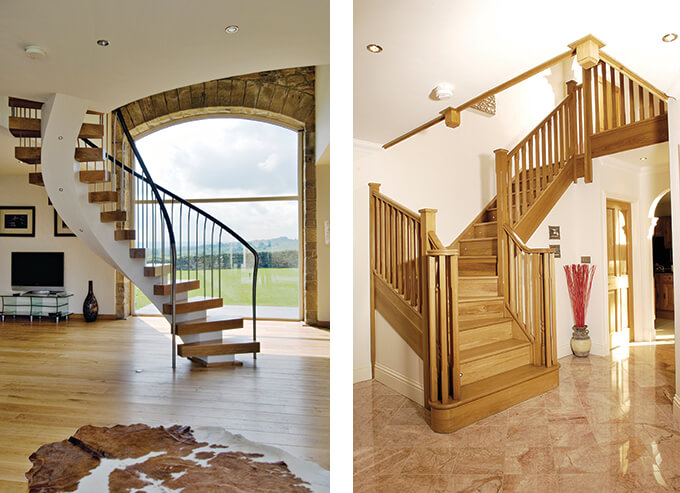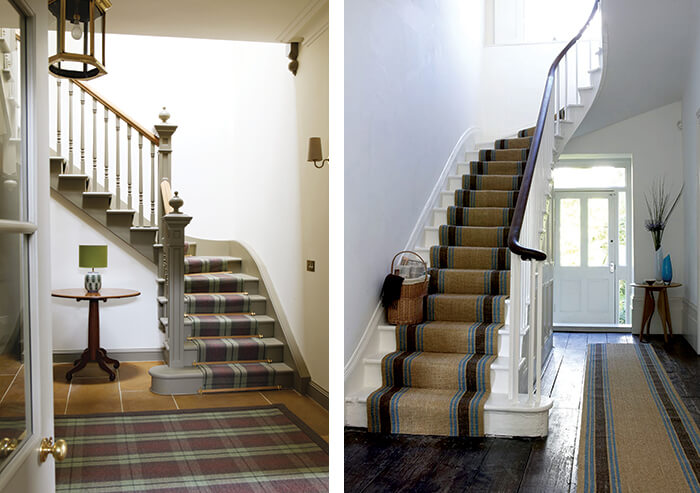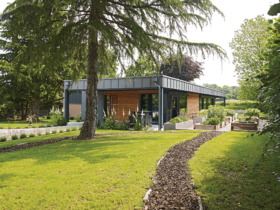
Use code BUILD for 20% off
Book here!
Use code BUILD for 20% off
Book here!In many ways, a good staircase is the backbone of a home; facilitating the flow between storeys and providing an eye-catching feature that can transform even the most modest of hallways into an inviting space.
The two main options for self-builders and renovators are made-to-measure flights or bespoke design, but how can you tell which option will best fit with your requirements – not to mention your budget?
When you buy a staircase from a big manufacturer, you’ll technically be purchasing a product that’s built-to-order. Elements such as the pitch, rise (height), going (depth) and number of treads must be customised to fit the dimensions of the space the flight will occupy; while you’ll also have access to a range of finishes.
Yet this route doesn’t give you a truly bespoke design. Instead, you’ll mix-and-match materials and components from the supplier’s pattern book to create a staircase that suits your needs.
The key advantage of the made-to-measure option is that it can give stylish results even on relatively tight budgets. These staircases are usually fabricated in softwood; although if they’re to be carpeted the treads and risers (which form the individual steps) may be of MDF and plywood to save money. As all the components are factory-made and based on existing designs, production costs are kept to a minimum – which is reflected in the final price.
“The entry-level Hemlock straight flight is our most cost-effective design,” says Phil Chimento, co-ordinating general manager at Jeld-Wen. “But you can easily upgrade and customise. Adding glass to the balustrade can help to create the illusion of more space, for example, while you can achieve a premium look on a basic stair simply by switching to oak components.”
Another plus point is that you’ll get a quick turnaround with most made-to-measure flights. “Time is money on a self-build or major renovation, so it’s important to consider lead times and product availability,” says Phil. “A big supplier will have a large workforce that can easily meet project deadlines.”

Left: Bisca bespoke helical staircase. Right: Jeld-Wen quarter-turn staircase
It’s vital that you provide the correct measurements to the supplier. “Getting this wrong by even a few millimetres can prove costly, as the staircase won’t fit correctly and safety will be compromised,” says Phil. In the worst case scenario, you may end up with a design that can’t be adjusted to fit or won’t make it through Building Regs.
There’s plenty of advice online to help you get to grips with calculating technical elements, such as the rise and going of each step as well as the overall flight. But if possible, you should seek advice from your architect, builder or joiner.
Many large manufacturers offer a free-of-charge measuring service through their installer networks, which takes the hassle out of the process – not to mention giving you the reassurance that a professional is involved in specifying the configuration.
A standard straight flight in timber can be picked up for as little as £500 with a matching softwood balustrade, and will be made-to-measure to fit the dimensions you’ve supplied. It could arrive pre-painted or be finished on site; and fitted with carpet or stair runners as required.
Incorporating winders or a quarter-turn will typically add £200-£300; so changing the configuration can be an affordable way to add a little character to your interiors.
If you want to upgrade to oak strings, newel posts and balustrading then prices are likely to start from at least £1,500. At the top end of the made-to-measure scale is solid hardwood, with versions in European oak beginning at around £10,000 – but you can expect better durability and a characterful look.
More often than not, the feature staircases that grace your fellow Build It readers’ homes are tailor-made. These flights are usually conceived by an architect or bespoke manufacturer, and realised by a specialist company – although just occasionally it’s the self-builder themselves who puts a plan together.
“A custom-built arrangement is as unique as the client and their property,” says Richard McLane, design director at Bisca. “Maximising or minimising a staircase’s visual impact to suit the space is probably the key issue that homeowners find daunting. Specialists not only know the Building Regulations inside and out, but can also bring their experience to bear and envisage what’s possible and what won’t work on a given project – both in terms of the overall look and how the staircase responds to the space available.”
The hidden elements of a well-designed stair underpin its quality. “Properly thought-out interfaces, fixings and fittings may not be top of every homeowner’s wish list, but they can make a huge difference to a project,” says Richard, who prefers to get involved as early in the process as possible.
“On a self-build, this means we can work with the architect to open up the full palette of materials and styles – not just timber. Whilst joiners can do an admirable job, they’re not designers. As staircase specialists we look at all the options, from headroom through to balustrading requirements, ascent/descent directions and more.”

Left: Kelaty bespoke staircase. Right: Marrakech stair runner by Naken Interiors
As with any project where you’re setting a lot of store by the aesthetics, it can be easy to get carried away with all the configuration and materials options put in front of you. But it’s important to take a step back and consider the practicalities, too.
If your staircase is going to be used by children or elderly members of the family, for example, hard surfaces like stone and concrete may not be the best choice. Wood and carpet are much more forgiving – and are just as suited to creating timeless features.
When it comes to going bespoke, then, you should treat the relationship with your designer much as you would that with an architect for a full self-build. Are they asking questions about how you and your family want to use the space, or are they focussed purely on aesthetics and technical detail?
Check their lead times, too – for the design stages as well as the delivery and installation of your new stair. And don’t be afraid to ask about pricing and payment terms – if they want a deposit, what percentage will it be and how will this affect your project cashflow?
As a rule, you should be able to commission a bespoke design for anything from £15,000 upwards. Depending on the size and complexity of the staircase, however, you might need to budget £20,000 or more.
“It’s not always about money, but I believe that spending £20,000 on a timeless architectural feature that’s integral to the property – and will last for its lifetime – is good value and can easily be recouped in the market worth of the finished home,” says Richard.
“Arguably, it’s better than spending the same amount on a kitchen or bathroom that’s likely to be ripped out and replaced within a few years when fashions change.”
Main photo: This oak staircase is part of an eco barn conversion

